The Fearless Tech Grad Who Changed 60 Skylines
By Ann W. Hoevel
When people describe John Portman, they need to use a lot of commas.
He was an architect, a developer, a city planner, an artist, a futurist, and most of all a risk-taker. As an alumnus of the College of Design—he graduated in 1950 with a Bachelor of Science in Architecture—his accomplishments resonate with the diverse educational philosophy that the College has held for many decades.
Portman, who died December 29, 2017, at the age of 93, had a multidisciplinary approach to the built environment. He had a habit of combining expertise in industries that were quite different, in ways that no one before him thought about.
He epitomized a way of thinking that merged the human experience with nature, neighborhoods, and cities. He was constantly curious. He was willing to operate contrary to the normal pattern. He persevered and evolved in the face of criticism.
As home to some of the most out-of-the-box thinkers at Georgia Tech, the College is devoted to that ideal.
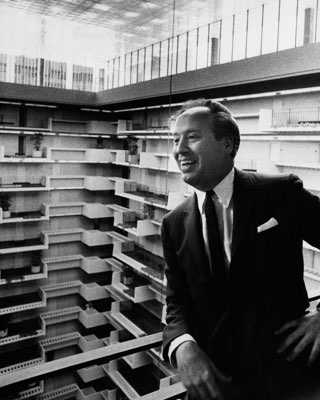
John Portman Jr. at Hyatt Regency, 1967. Credit: Leviton-Atlanta Editorial and Interpretive Photography, The Hyatt Regency Collection, The Portman Archive, LLC
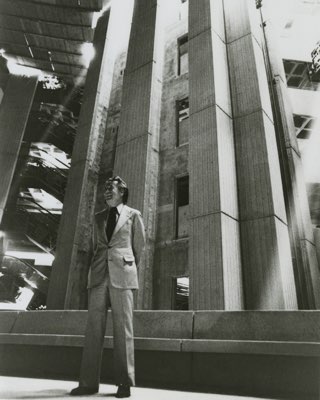
John Portman Jr. in the Atlanta Apparel Mart, circa 1979. Credit: Leviton-Atlanta Editorial and Interpretive Photography, The Hyatt Regency Collection, The Portman Archive, LLC

John Portman Jr. with Peachtree Center Model, 1989. Credit: Tom Hamilton, The John C. Portman, Jr. Collection, The Portman Archives, LLC
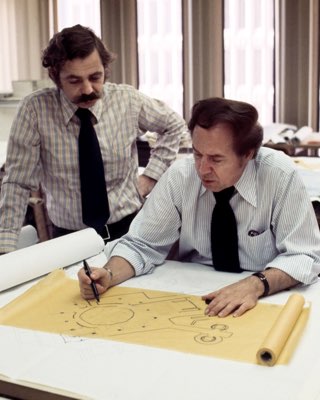
John Portman Jr. working with John Schlenkert, drawing for Renaissance Center. Credit: Ron Sherman, The John C. Portman, Jr. Collection, The Portman Archives, LLC
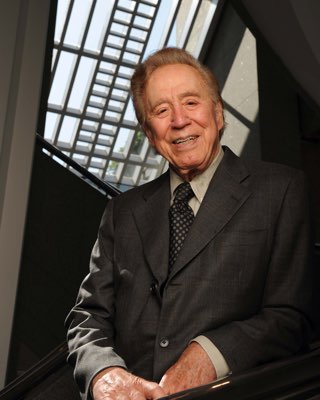
John Portman Jr. at SunTrust Plaza, 2008. Credit: Byron E. Small Atlanta Business Chronicle, The John C. Portman, Jr. Collection, The Portman Archives, LLC

John Portman, Jr. with SunTrust Plaza Model, 1988. Credit: Michael Pugh, The John C. Portman Jr. Collection, The Portman Archives, LLC







An Entrepreneurial Architect from Atlanta
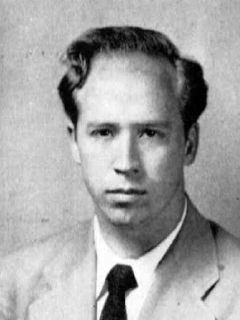
John Portman's 1950 Blueprint portrait. Credit: Georgia Tech Blueprint
Portman grew up and went to school in Atlanta. His entrepreneurial spirit was obvious as a young child—his first "franchise plan" was selling gum in front of movie theaters. As a 15-year-old, he persuaded his teachers to let him learn architecture drafting instead of mechanical engineering drafting at Tech High School.
Having this particular blend of conceptual creativity and technical curiosity is a powerful combination for any architect, said fellow Georgia Tech School of Architecture graduate, Tristan Al-Haddad.
Al-Haddad, a part-time lecturer at the School, who earned his bachelor's and master's degrees there, also grew up in Atlanta. He first encountered Portman's work in high school.
"I used to ride the 121 MARTA bus down Memorial Drive to downtown when I ran a storefront window washing business as a student," Al-Haddad said. The architectural diversity he experienced in downtown Atlanta became a life-long influence.
"I learned a tremendous amount from walking around on the streets, looking at the buildings. I studied, in an informal manner, the architectonic sensibility of each structure. Of course, I didn't know the word ‘architectonic’ when I was 15, but I learned so much just by walking around downtown Atlanta."
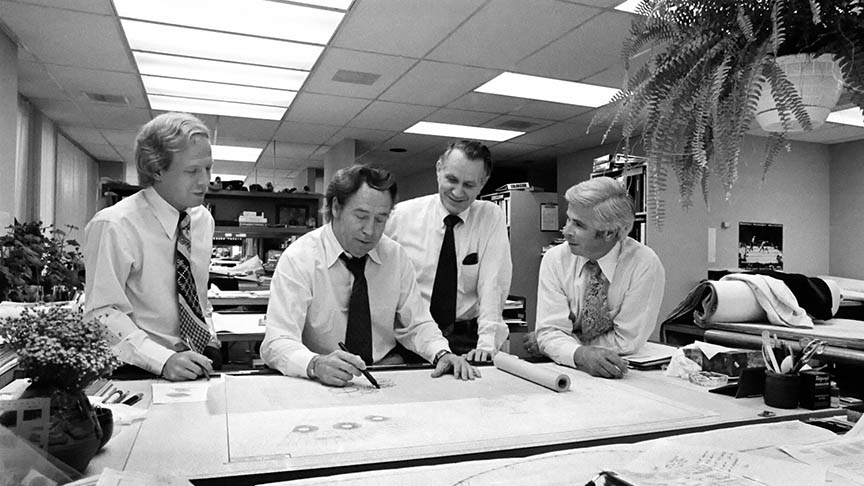
From Left: Jack Portman, John Portman Jr., John Street, and Herb Lembke, working on a drawing of support columns circa 1975. Credit: Jerry Spearman, The John C. Portman, Jr. Collection, The Portman Archives LLC
As an accomplished researcher and artist, Al-Haddad said Portman set the example for architects who want to shepherd their practice into a new age.
"Fundamentally, Portman was a typological innovator," he said. "He understood the history and evolution of architecture and realized that he could continue that tradition of innovation by restructuring how buildings are organized."
Portman embodied a spirit of experimentation, exploration, novelty, and innovation, Al-Haddad said. That same spirit that has been "part of the cultural milieu of teaching and learning in the School of Architecture at Georgia Tech."
“…innovation by restructuring how buildings are organized.”
Portman's lack of complacency is also a familiar, signature character trait of Georgia Tech architecture students, he said.
"With a strong vision of what the city should be and how his work would help accomplish that vision, he went out and found the opportunities and the partners needed to make it happen," he said. "I think this ‘can-do, will-do’ spirit informed both my teaching and research at Georgia Tech, and my creative practice at Formations Studio."

Maverick Move to Real Estate Development
Rick Porter also earned his architecture degree from Georgia Tech, but became a developer after graduation.
As the director of the Master in Real Estate Development program for the School of Building Construction, Porter aims to concentrate Portman's values and inspirations into a post-secondary degree.
"I think he understood the collaborative approach that was necessary to deliver the built environment," Porter said. "He combined numerous disciplines: planning, design, construct, business, engineering. They all have to come together in the development world."
"Portman made the development community understand the critical element of design, more than anyone. He was not a developer that went to a consultant for design work." In doing so, Portman was able to merge human experience with the natural environment through his buildings.
“He was undaunted…He failed sometimes.”
Porter looks to Peachtree Center as an example of Portman's blend of design and development. "The 'buzz,' if you will, of Peachtree Center always strikes me," he said. "It's a beehive of human activity."
"At the end of the day, developers create spaces that can be used over time, and produce a value that was not there before. I think Peachtree Center does that. It's got commerce, food, human activity, pleasure, nature, all of those things. It's a better place than it was before Portman came there."
The educational key that makes something like Peachtree Center possible, Porter said, is an iterative process that breeds curiosity.
"Everything we do is iterative," Porter said. "This is not a linear process whereby you go on to step two and then you go on to step three. If you think that way, it is very difficult to be curious enough to continue."
Porter views Portman as a man who took curiosity and iteration to an extreme. "He was undaunted," Porter said. "And it didn't always work. He failed sometimes."

John Portman Jr. sitting in the middle of Peachtree Center in downtown Atlanta, circa 1988. Credit: Flip Chalfant, The John C. Portman, Jr. Collection, The Portman Archives, LLC

Peachtree Center includes Americas Mart, SunTrust Plaza, Atlanta Marriott Marquis, Hyatt Regency Atlanta, The Westin Peachtree Plaza, and several other buildings. Credit: Photo courtesy of John Portman & Associates
As a former Tech student, and now a professor of practice, Porter sees the courage to fail as an undeniable aspect of studying at Georgia Tech. He tells his students that being curious enough to fail is what will lead to something bigger.
"You're going to fail more than you succeed here, but the resilience to embrace that failure is an important Georgia Tech way," Porter said. "I can almost tell you to the detail, a third-quarter design project that I had as an undergraduate, and I just got crushed on it. I probably remember that more than some of my successes."
Portman's life and work provide quintessential examples of fearlessness for his students, Porter said.
"He was willing, as an architect, to risk developing a product that might not show design deficiencies until delivery," he said. "Portman was curious enough, and at the same time, plucky, confident, almost cocky enough to then go on to say, 'I can go to China and do this.' "

Caring About Communities Like a Planner

John Portman Jr. received an honorary Ph.D. during the Fall 2012 Commencement Ceremony.Credit: Rob Felt, The John C. Portman, Jr. Collection, The Portman Archives, LLC
Portman's work is often criticized as being "fortresses, these concrete facades in downtowns that separate citizens from the city," said Catherine Ross, the Harry West Professor in the School of City & Regional Planning, as well as the director of the Center for Quality Growth and Regional Development.
"I think that gave rise to an increased connection in cities, a focus on pedestrians," she said. "Out of his work came what city planners are talking about now: the smart city, the city that gives priority to pedestrians, connecting cities of all sizes and scales through space, and the importance of that in terms of community and places."
Ross views her work as a continuation of Portman's logic. "People were walking away from the city, and Portman said, 'No. Let's go downtown and remake the city. We can re-create this, we can create vistas that empower people and bring economic activity.' "
Portman's decisions gave rise to an outstanding career and allowed him to make contributions globally. "Shanghai, San Francisco, Atlanta, it doesn't matter where you look. Sixty different cities have his brand on them," she said.
“Portman said, ‘No. Let's go downtown and remake the city.’ ”
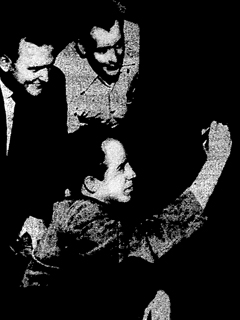
Georgia Tech students work on the 'Do Over' house as part of a school project. Left to right: Harry Porter, George Phillips, and John Portman with brush. Credit: Constitution Staff—Carl Dixon
And while it may seem like Portman's signature move was to zig when other architects and developers zagged, Ross said an underlying empathy strongly links Portman to the planning profession.
"He worried about communities," she said. "Most architects, appropriately, worry about buildings—and they should. I think Portman was bigger than that. He may not have always got it right, but I think he worried about communities, and neighborhoods, and people, and the idea that buildings should work for people. That's what city planning is."
Portman's passion project of planting trees along Peachtree Street in downtown Atlanta is also something planners aspire to, she said.
"Anytime you can create an experience with greens and infrastructure, and Peachtree is a classic example, it enhances the environment for whoever is enjoying the benefit of that space. It's no doubt that those trees are an outreach on Portman's part, to be more inclusive, more responsive."
"Whether people are walking, riding, or driving, they can have an experience with nature on Peachtree Street," Ross said. "That's a very popular planning strategy, and I think a correct one, as we talk about revitalizing our avenues and boulevards in cities."
Likewise, Portman's design innovations have had lasting effects on cities all over the planet. For example, the glass elevator he invented for his atrium concept in the Hyatt Regency in downtown Atlanta was the most expensive elevator, at that time, in the world, she said.
"I was in Asia this summer, and as I looked at the glass elevators all over Asia, I thought, 'That's Portman!' "
"He gave people a different view of the city from that elevator, a way to get outside that building. It's completely the model. And Asia is the best place to see it. The idea of this glass elevator has taken hold in a way that I think is uncanny," she said.
You don't look at Portman's work and feel nothing, Ross said. "It's rousing and inspirational, that's how his work gets me. What Portman did was create a renaissance, a rebirth. That's huge! And it inspires us at Tech," Ross said.